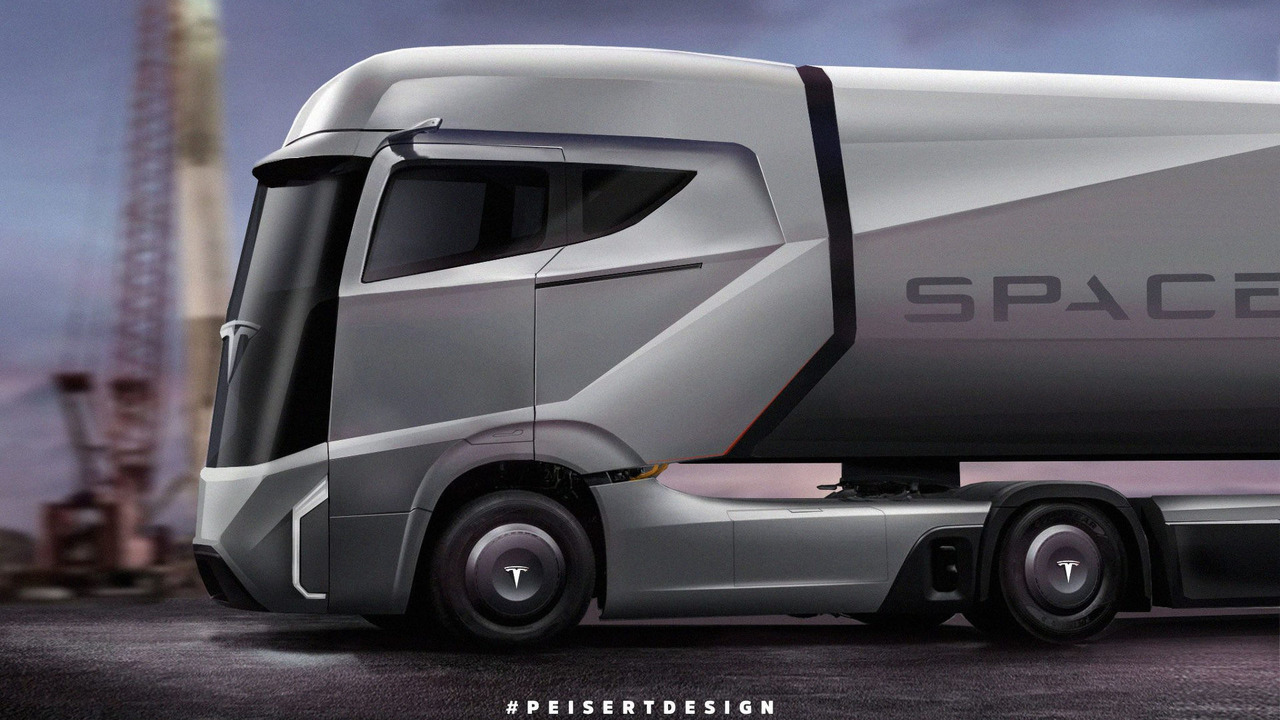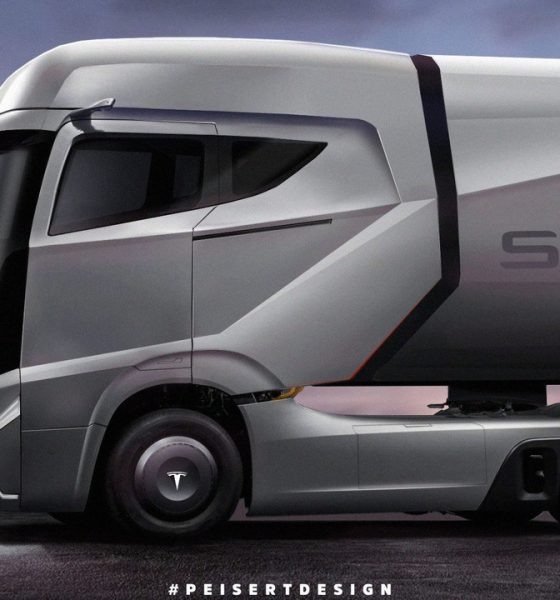

News
Tesla Semi-truck due to arrive in September, “Seriously next level”
Elon Musk is on the loose again tweeting important details about Tesla’s future product lines. The multi-billionaire tech entrepreneur has announced that the Tesla semi-truck will be unveiled this September and will be “seriously next level”. He had previously spoken about a semi-truck that would be far better than anything on the road, and by reading into the statement one can presume that the next level he’s referring to is Level 4 or Level 5 autonomy.
Tesla Semi truck unveil set for September. Team has done an amazing job. Seriously next level.
— Elon Musk (@elonmusk) April 13, 2017
Musk also previously stated in February that the “Model 3 is the overwhelming priority” but is making good progress with the semi-truck development. Former VP of Worldwide Sales and Service Jerome Guillen is now leading the development of Tesla’s Trucks and Programs initiative which began over a year ago. Guillen was previously General Manager of New Product development at Freightliner, an American truck manufacturer best know for its heavy duty class 8 diesel trucks. His LinkedIn profile lists his current position at Tesla as VP of Trucks and Programs.
“Jerome is driving the Tesla Semi & and is doing a great job with his team. At Daimler he lead the most successful semi truck program ever.” said Musk last year in reply to a tweet asking about Jerome’s return to Tesla.
Jerome is driving Tesla Semi & doing a great job with his team. At Daimler, he led their most successful semi truck program ever.
— Elon Musk (@elonmusk) July 21, 2016
The semi-truck market could be a huge market for Tesla, as 70% of US freight move through semi-trucks. We previously analyzed how Tesla could target the semi-truck market and the potential development issues. Though the potential market for Tesla is staggering, it’s also fraught with a lot of implications. Semi-trucks typically drive millions of miles and are some of the largest polluters in the world. Tesla’s electric truck could take thousands of these dirty trucks off the road, making our air cleaner and quieter, but battery technology and Tesla’s charging network would need to be able to support the extreme long distance travel and weight often associated with this industry.
One of Tesla’s co-founders, Ian Wright, has been targeting the commercial trucking industry for over a decade had been working on hybrid powertrains to help curb costs and emissions. Wrightspeed was founded in 2005 and has raised $40M in venture capital funding since. Ian Wright left Tesla when Elon Musk came onboard. The thought of an electric sports car didn’t resonate and he wanted to pursue an electric vehicle that solved larger pollution issues – trucks.
Ryan Popple, CEO of Proterra, the electric bus maker, speculates that the Tesla semi-project could be more for internal use than initially expected. “A fairly reasonable idea would be to move battery packs from the Gigafactory downhill to the assembly plant in Fremont, California. The reason I say that could be viable is they’re fundamentally transporting battery packs. They could build battery packs and put them into a truck that’s optimized for the shipment of those packs, charge them with solar as a way of validating the pack, and transport them at maybe 50 or 60 percent state of charge.”
Only time will tell what Elon has envisioned for the future of the trucking industry.

News
Tesla FSD fleet is nearing 7 billion total miles, including 2.5 billion city miles
As can be seen on Tesla’s official FSD webpage, vehicles equipped with the system have now navigated over 6.99 billion miles.

Tesla’s Full Self-Driving (Supervised) fleet is closing in on almost 7 billion total miles driven, as per data posted by the company on its official FSD webpage.
These figures hint at the massive scale of data fueling Tesla’s rapid FSD improvements, which have been quite notable as of late.
FSD mileage milestones
As can be seen on Tesla’s official FSD webpage, vehicles equipped with the system have now navigated over 6.99 billion miles. Tesla owner and avid FSD tester Whole Mars Catalog also shared a screenshot indicating that from the nearly 7 billion miles traveled by the FSD fleet, more than 2.5 billion miles were driven inside cities.
City miles are particularly valuable for complex urban scenarios like unprotected turns, pedestrian interactions, and traffic lights. This is also the difference-maker for FSD, as only complex solutions, such as Waymo’s self-driving taxis, operate similarly on inner-city streets. And even then, incidents such as the San Francisco blackouts have proven challenging for sensor-rich vehicles like Waymos.
Tesla’s data edge
Tesla has a number of advantages in the autonomous vehicle sector, one of which is the size of its fleet and the number of vehicles training FSD on real-world roads. Tesla’s nearly 7 billion FSD miles then allow the company to roll out updates that make its vehicles behave like they are being driven by experienced drivers, even if they are operating on their own.
So notable are Tesla’s improvements to FSD that NVIDIA Director of Robotics Jim Fan, after experiencing FSD v14, noted that the system is the first AI that passes what he described as a “Physical Turing Test.”
“Despite knowing exactly how robot learning works, I still find it magical watching the steering wheel turn by itself. First it feels surreal, next it becomes routine. Then, like the smartphone, taking it away actively hurts. This is how humanity gets rewired and glued to god-like technologies,” Fan wrote in a post on X.
News
Tesla starts showing how FSD will change lives in Europe
Local officials tested the system on narrow country roads and were impressed by FSD’s smooth, human-like driving, with some calling the service a game-changer for everyday life in areas that are far from urban centers.

Tesla has launched Europe’s first public shuttle service using Full Self-Driving (Supervised) in the rural Eifelkreis Bitburg-Prüm region of Germany, demonstrating how the technology can restore independence and mobility for people who struggle with limited transport options.
Local officials tested the system on narrow country roads and were impressed by FSD’s smooth, human-like driving, with some calling the service a game-changer for everyday life in areas that are far from urban centers.
Officials see real impact on rural residents
Arzfeld Mayor Johannes Kuhl and District Administrator Andreas Kruppert personally tested the Tesla shuttle service. This allowed them to see just how well FSD navigated winding lanes and rural roads confidently. Kruppert said, “Autonomous driving sounds like science fiction to many, but we simply see here that it works totally well in rural regions too.” Kuhl, for his part, also noted that FSD “feels like a very experienced driver.”
The pilot complements the area’s “Citizen Bus” program, which provides on-demand rides for elderly residents who can no longer drive themselves. Tesla Europe shared a video of a demonstration of the service, highlighting how FSD gives people their freedom back, even in places where public transport is not as prevalent.
What the Ministry for Economic Affairs and Transport says
Rhineland-Palatinate’s Minister Daniela Schmitt supported the project, praising the collaboration that made this “first of its kind in Europe” possible. As per the ministry, the rural rollout for the service shows FSD’s potential beyond major cities, and it delivers tangible benefits like grocery runs, doctor visits, and social connections for isolated residents.
“Reliable and flexible mobility is especially vital in rural areas. With the launch of a shuttle service using self-driving vehicles (FSD supervised) by Tesla in the Eifelkreis Bitburg-Prüm, an innovative pilot project is now getting underway that complements local community bus services. It is the first project of its kind in Europe.
“The result is a real gain for rural mobility: greater accessibility, more flexibility and tangible benefits for everyday life. A strong signal for innovation, cooperation and future-oriented mobility beyond urban centers,” the ministry wrote in a LinkedIn post.
News
Tesla China quietly posts Robotaxi-related job listing
Tesla China is currently seeking a Low Voltage Electrical Engineer to work on circuit board design for the company’s autonomous vehicles.

Tesla has posted a new job listing in Shanghai explicitly tied to its Robotaxi program, fueling speculation that the company is preparing to launch its dedicated autonomous ride-hailing service in China.
As noted in the listing, Tesla China is currently seeking a Low Voltage Electrical Engineer to work on circuit board design for the company’s autonomous vehicles.
Robotaxi-specific role
The listing, which was shared on social media platform X by industry watcher @tslaming, suggested that Tesla China is looking to fill the role urgently. The job listing itself specifically mentions that the person hired for the role will be working on the Low Voltage Hardware team, which would design the circuit boards that would serve as the nervous system of the Robotaxi.
Key tasks for the role, as indicated in the job listing, include collaboration with PCB layout, firmware, mechanical, program management, and validation teams, among other responsibilities. The role is based in Shanghai.
China Robotaxi launch
China represents a massive potential market for robotaxis, with its dense urban centers and supportive policies in select cities. Tesla has limited permission to roll out FSD in the country, though despite this, its vehicles have been hailed as among the best in the market when it comes to autonomous features. So far, at least, it appears that China supports Tesla’s FSD and Robotaxi rollout.
This was hinted at in November, when Tesla brought the Cybercab to the 8th China International Import Expo (CIIE) in Shanghai, marking the first time that the autonomous two-seater was brought to the Asia-Pacific region. The vehicle, despite not having a release date in China, received a significant amount of interest among the event’s attendees.








